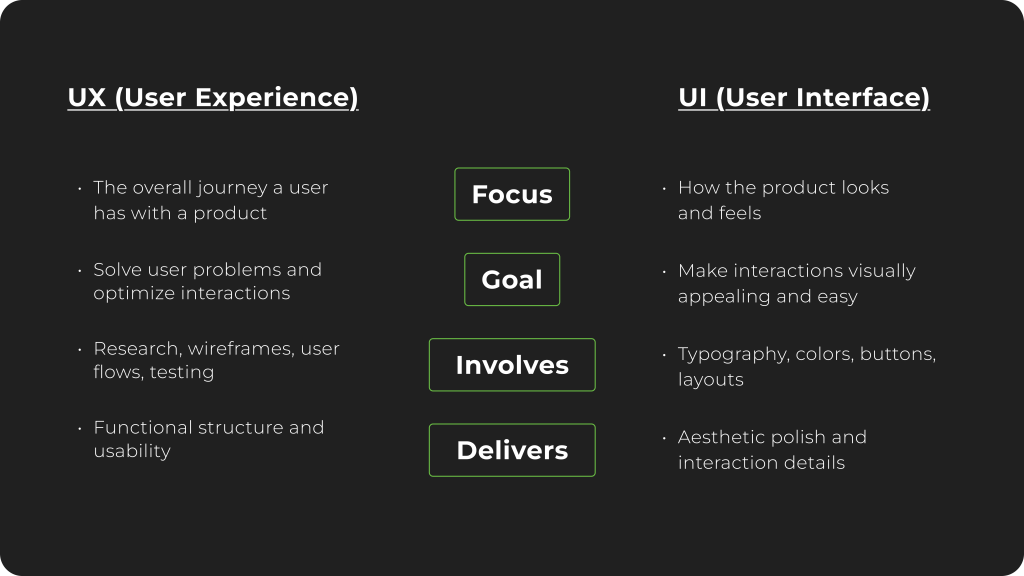The software development lifecycle (SDLC) is a structured process that guides development teams in creating excellent-quality software successfully and cost-effectively.
UX Design 2025: Make or Break Your Product
UX Design 2025: Make or Break Your Product
Link Copied
- July 4, 2025
Imagine pouring $1 into your business and getting $100 back. That’s not a marketing fantasy, it’s the real-world ROI of investing in User Experience design. In a digital economy where milliseconds determine whether users stay or leave, UX has evolved from a “nice-to-have” to a bottom-line business strategy.
But great UX in 2025 goes far beyond polished visuals. As Paul Boag notes in The State of UX in 2025, the role of UX is evolving, not fading. While automation and AI may streamline parts of the design process, they don’t replace what makes UX essential: empathy, clarity, and the ability to guide users through complexity with ease.
In reality, good UX isn’t about “pretty screens”, it’s about solving real problems. What matters is whether the experience works. That’s why UX today is deeply tied to business outcomes, retention, loyalty, and revenue. It’s no longer a support function, it’s a strategic driver of growth.
This article breaks down why UX is far more than “just pretty screens,” and how many founders still confuse it with UI, leading to costly missteps. You’ll learn the critical business impacts of UX, including how it boosts retention, drives conversions, and reduces long-term costs.
UX vs. UI: Understanding the Difference Most Founders Overlook
Although often used exchangeable, UX (User Experience) and UI (User Interface) refer to distinct aspects of digital product design. Understanding the difference is essential for building products that not only look great but also deliver meaningful, intuitive experiences to users.
Defining UX vs. UI
At its core, UX design focuses on the overall experience a user has when interacting with a product or service. It’s about how the product works, how easy it is to navigate, how well it solves the user’s problem, and how the experience feels from start to finish. UX involves research, user journey mapping, wireframes, usability testing, and ongoing iteration based on feedback and analytics.
In contrast, UI design is about the visual and interactive elements of a product interface. It includes layout, colors, fonts, icons, buttons, and animations, everything the user sees and interacts with on a screen. UI design ensures that the interface is visually coherent, on-brand, and accessible.

You can have a beautiful interface that’s confusing to use (good UI, poor UX), or a functional layout that lacks visual appeal (good UX, weak UI). The best products deliver on both fronts.
UX and UI are two sides of the same coin, you can’t build a successful digital product with one and not the other. While UX ensures the product solves the right problems in the right way, UI ensures it’s easy and enjoyable to use.
In the end, a product’s success depends on how well these two disciplines work together to create a seamless and meaningful experience.
Business Impacts of UX You Can’t Ignore
Leading companies now use UX as a smart strategy to improve their products and grow faster.
Here’s how great UX design helps businesses succeed in the long run:
1. Customer Loyalty Begins with Experience
Exceptional UX fosters trust, satisfaction, and emotional connection-the critical ingredients for customer loyalty. When users feel that a product is intuitive, enjoyable, and consistently helpful, they’re more likely to return and recommend it.
In a market where users expect the best, even small usability issues can make them leave. Loyal users not only reduce acquisition costs but become brand advocates, expanding your reach through referrals.
2. UX Optimizes Conversion Funnels
Every additional click, every second of delay, and every confusing UI element adds friction. Great UX simplifies the journey from interest to action, whether it’s completing a sign-up, purchasing a product, or submitting a form.
By eliminating barriers and designing seamless flows, businesses see measurable increases in conversion rates. Thoughtful UX doesn’t just support engagement, it turns it into revenue.
3. Informed Decision-Making Through User Data
UX is inherently user-centric and iterative, meaning it thrives on insights. Feedback loops, behavior analytics, and usability testing uncover what users actually need and how they interact with your product.
This evidence-based approach supports better business decisions, whether in feature prioritization, marketing, or long-term strategy, by ensuring they’re grounded in real user data, not assumptions.
4. Stronger Brand Perception and Credibility
A consistent, accessible, and well-crafted UX reinforces your brand promise. It shows that your company values attention to detail and user success. That trust is hard to win, but great UX earns it.
Poor usability, on the other hand, signals a lack of care or competence. And customers take notice.
5. Lower Churn, Higher Retention
When users struggle to understand or navigate your product, they leave. Great UX helps you retain the right users, those who gain value quickly and stay longer. It also helps filter out those who aren’t a fit, which leads to better product-market alignment and reduced churn.
What’s Shaping the Future of Digital Experience
1. Thoughtful AI Integration & Generative UI
AI moves from hype to practical enhancement. UX teams are now applying AI with purpose, automating repetitive tasks and generating design suggestions, while ensuring human oversight, empathy, and clarity remain central.
2. Renewed Focus on Accessibility & Inclusive Design
In 2025, it’s important both ethically and for business to create easy-to-use designs that everyone can access, like using keyboard navigation, good color contrast, screen-reader support, and inclusive language.
3. Sustainability & Ethical UX
Sustainable UX considers digital carbon impact, reduces tech waste, and promotes ethical design. Expect greener hosting, mindful user flows, and privacy-centered experiences.
4. Strategic UX: Research + Business Thinking
UX is becoming more strategic, grounded in rigorous research, metrics, and business goals. UX pros are evolving into strategy roles, bridging user needs and organizational objectives.
5. Hyper-Personalization
User experiences are tailoring content, recommendations, and UI based on individual behavior and preferences,driven by real-time data and machine learning.
6. Immersive & Dynamic Interfaces
Expect to see more interactive 3D elements, ambient animations, and dynamic UI components that engage users in more tactile and immersive ways).
7. Micro-Interactions 2.0 & Attention to Detail
Intelligent animations and feedback that anticipate user actions are evolving,adding polish, increasing engagement, and reinforcing usability.
8. Modern Visual Language: Minimalism & Bold Contrast
Design trends favor clean layouts and minimalist aesthetics balanced with bold, high-contrast color palettes to create visual impact and brand differentiation.
9. Tools & Workflow Enhancements
The rise of remote teams means shared platforms like Figma, Lottie, and no-code tools (e.g., Webflow, Canva) are now essential for design collaboration and prototyping.
10. Cross-Functional Collaboration
UX/UI is becoming more integrated across teams,designers working with developers, PMs, and business leaders,supported by unified workflows and collaborative environments.
Curious how these trends apply to your product?
Get a free UX consultation with our team.
Summary
In 2025, user experience (UX) is more crucial than ever, users won’t allow poor design, with 70% abandoning products due to bad UX. Good UX directly impacts business by increasing user retention, boosting conversions, and reducing costly fixes. Warning signs of weak UX include onboarding drop-offs, frequent support requests, and user confusion. Staying ahead means embracing 2025’s UX trends and treating UX as a key growth driver.
Related Articles
Understanding SDLC Phases And Common Challenges in 2024
The software development lifecycle (SDLC) is a structured process that guides development teams in creating excellent-quality software successfully and cost-effectively.
Enhance Database Efficiency
This article discusses performance bottlenecks in databases and software services, explaining the issues and how to find and fix them.




